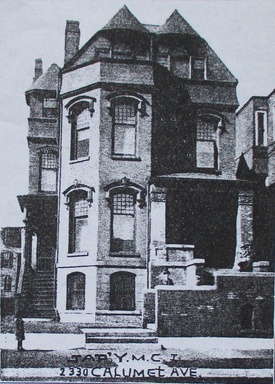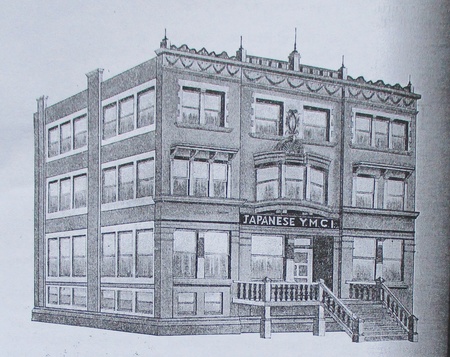Changing Demographics
As a result of escalating anti-Japanese discrimination on the West Coast in the early 20th century, Chicago saw a new influx of young adult Nisei who had been born in other areas such as Hawaii, Utah, California, and Arkansas. The demographics of Japanese Chicago began to change as a result of social and generational shifts.
Among the newcomers, the Hawaii Nisei were the biggest group, totaling seven people according to the 1920 Census. One of them was Isamu Tashiro, a dentist, who was born in Hawaii in 1895, came to Chicago at age 16, and graduated in 1918 from the Chicago College of Dental Surgery. He practiced dentistry for more than 60 years in Chicago, and served as a local contact for dental students from Hawaii and Japan.1 In the 1920s, Hawaiian Nisei began to appear among the graduates of the University of Chicago. In May 1922, Japanese students from Hawaii formed two clubs: the Hawaiian Students Club and the Aloha baseball team.2
Nisei women also came to Chicago. In the 1920s, a single Hawaiian Nisei woman came to study at the Moody Bible Institute3 and an Arkansan Nisei woman settled in Chicago with her black husband.4
The Japanese population in Illinois grew to 471 (368 males, 103 females) in 1920.5 There were 422 Japanese (330 males, 92 females) living in Chicago, and there appeared to be some single women working outside Chicago. The percentage of interracial marriages decreased somewhat: out of 92 married Japanese men, 29 had white wives and one had a black wife. The percentage of mixed-blood Nisei, on the other hand, increased: they numbered 40 (13 boys and 27 girls), making up nearly 49 percent of the 82 Nisei under age 18.
The Japanese population in Chicago reached 515 (369 males, 146 females) in 1930.6 The 1930 Census saw the first appearance of “intra-racial” marriages between Japanese Issei and Nisei from other areas, and the number has steadily increased since then. Out of 584 Japanese residents in Illinois, the biggest group was children under 18, who numbered 149 (65 boys and 84 girls); 37 percent of these (19 boys and 37 girls) were of mixed blood. The number of mixed-blood Nisei started to decline while the number of “pure Japanese” children rose with the number of Nisei marriages.
The children’s birthplaces varied. They came from not only Illinois and Japan, but all regions of the country. Apparently, Japanese immigrants were on the move throughout the US to seek better lives for their families, especially after 1924. The 1930 Census for the first time showed Japanese children in orphanages and in white families, likely as adoptees. In 1931, a two-year-old, mixed-blood boy named Alexander Hayes was adopted by Japanese movie stars Sesshu and Tsuru Hayakawa. Among local Japanese, he was rumored to have been born to a Japanese student and the daughter of a well-known Chicago businessman.7
Growing Community Consciousness
With more young adult Nisei in Chicago, a new sense of community consciousness seemed to emerge. One indicator of this was the opening of Japanese language schools, with the goal of fostering a lasting sense of Japanese ethnic identity over generations.
A Japanese language school was opened in 1931 at the Japanese Young Men’s Christian Institute of Chicago (JYMCI, 747 East 36th Street). The JYMCI was originally a boarding and meeting facility founded in 1911 at 3219 Groveland Ave by the Reverend Misaki Shimadzu, who served as executive secretary. Classes were held on Saturdays, with day classes from 2 p.m. to 5 p.m. and night classes from 7:30 p.m to 10 p.m. Launched with 13 pupils,8 the school grew to accommodate six classes, 35 students, and three teachers by 1934.9 The school celebrated New Year’s10 and the Emperor’s birthday.11
With the departure of Reverend Shimadzu for Shanghai in 1934, the management and future of the school was in trouble, although the JYMCI as an organization stayed open until September 1937.12 In 1935, however, a new organization called the Japanese Mutual Aid Society of Chicago (816 N. Clark Street) was formed and under their leadership, the Japanese language school was able to reopen on the Near North side of Chicago13 in 1936 with a new management plan.14
In May 1938, the Chicago Nisei community formed the Nisei Club with advice from Mr. Mori, assistant to the Japanese consul. The purposes of the club were to improve communication among Nisei, promote Nisei activities, and promote an amicable relationship between the US and Japan. The first president was mixed-blood Nisei Kiyoshi Franklin Chino and the first meeting was held at the University of Chicago’s International House.15 The club held a “Japan night” at the Germania Club and proceeds from the event were donated to the Japanese language school.16 In spring 1940, a Chicago radio station broadcast a chorus of Japanese songs sung by students at the school and club president Chino answered questions on the situation of Japanese people in Chicago and the US.17
As the Nisei Club grew, the community recognized the need to procure a physical space for the club that could also house the Japanese language school, the Boy Scout troop,18 the camera club, and various sports clubs. The decision was made to rent a building at 214 West Oak Street.19 Two months of fundraising and the donation of room furnishings such as tables, lamps, carpets, books, and other items from the community led to the establishment of a “home” for the Nisei Club in June 1941.20 The following month, the club held a sports day at which they enjoyed wrestling, boxing, kendo, judo, and other activities.21
The building on West Oak Street also housed the Japanese Mutual Aid Society of Chicago, JYMCI, Japanese Christian Church, Japanese Ladies’ Association, and the branch office of the San Francisco Nichibei (Japanese American News).22 The birth and growth of the Nisei Club with Nisei leadership had finally enabled the creation of a kind of “Little Tokyo” for Japanese residents of Chicago.
World War II and Its Aftermath
After Japan bombed Pearl Harbor on December 7, 1941, the Chicago Police Department ordered the Japanese Mutual Aid Society to cease all activities and stop collecting dues. Members were also prohibited from congregating in groups of more than three persons.23 Then, beginning in 1942, Japanese Americans from camps began to resettle in Chicago, thus beginning a new phase of Chicago’s Japanese American history. In 1943 and the early part of 1944, almost all resettlers coming to Chicago—nearly 5,000 people—were Nisei24 and 50 percent of them were under the age of 24. Only one third of them were married.25
To the young resettlers, who had been raised in the more “ingrown than expanding” West Coast Japanese communities, where collectivity was prioritized,26 the Chicago Issei appeared to be “extreme individualists.”27 The Chicago Nisei who were “never a part of the Japanese community and whose ideas [were] so different from those of most resettlers that they [did] not have following” among the new settlers, were said to be “extremely unpopular or thoroughly disliked by the others.”28
The prewar Chicago Japanese might be a good example of how the size of a population, in tandem with its social distance from mainstream society, can inform the character of a minority community, which in this case deviated from what we might expect of typical, traditional Japanese communities in the US. As such, this community should be noted and remembered as a unique, atypical group of Japanese Americans who had the wisdom to survive in the particular atmosphere of Chicago, an atmosphere in which, according to resettler Setsuko Nishi, “negligent indifference and ignorance, if not acceptance, not prejudice and discrimination”29 prevailed.
Notes:
1. Chicago Tribune, December 21, 1983.
2. Nichibei Jiho, May 27, 1922.
3. Nishimura, 1920 Illinois Census.
4. Barrett, 1920 Illinois Census.
5. The 1920 Illinois Census recorded 472 Japanese in total.
6. The 1930 Illinois Census recorded 564 Japanese in total. According to the author’s research, 584 Japanese lived in Illinois—419 male and 165 female. Japanese living outside Chicago totaled 69: 50 male and 19 female.
7. Nichibei Jiho, September 2, 1931.
8. Nichibei Jiho, October 17, 1931.
9. Survey on Japanese language schools, December 1934, from Kenji Nakauchi, consul in Chicago to Japanese foreign ministry.
10. Nichibei Jiho, January 6, 1932.
11. Nichibei Jiho, April 24, 1937.
12. Yamagata’s letter to Cashman, June 30, 1937, YMCA of Metropolitan Chicago Collection, Chicago History Museum.
13. Japanese Mutual Aid of Chicago 1934–1977, leaflet from the collection of the Japanese American Service Committee Legacy Center, Chicago, page 3.
14. Nichibei Jiho, March 21, 1936.
15. Nichibei Jiho, May 21, 1938.
16. Nichibei Jiho, December 10, 1938.
17. Nichibei Jiho, April 27, 1940.
18. A Nisei lawyer from Oregon, Minoru Yasui, who came to Chicago in 1939, was the scoutmaster. Robinson, The Great Unknown, page 32.
19. Nichibei Jiho, March 22, 1941.
20. Nichibei Jiho, April 26, May 3, May 24, June 7, 1941.
21. Nichibei Jiho, July 5, 1941.
22. The Japanese American Directory 1941, page 659.
23. Japanese Mutual Aid of Chicago 1934–1977, leaflet from the collection of the Japanese American Service Committee Legacy Center, Chicago, page 3.
24. Indefinite Leaves-Departures by Center, Monthly Report/1 No.47, May 31, 1944, War Relocation Authority, Japanese American Relocation Collection, Box 5, Brethren Historical Library and Archives.
25. Relocation of Japanese Americans in Chicago, Chicago War Relocation Authority, 1945, page 1, Japanese American Relocation Collection, Box 5, Brethren Historical Library and Archives.
26. Setsuko Matsunaga Nishi, Japanese American Achievement in Chicago: A Cultural Response to Degradation, PhD dissertation, University of Chicago, 1963, page 73.
27. Ibid, page 305.
28. Ibid, pages 158–59.
29. Ibid, pages 215–16.
© 2018 Takako Day







